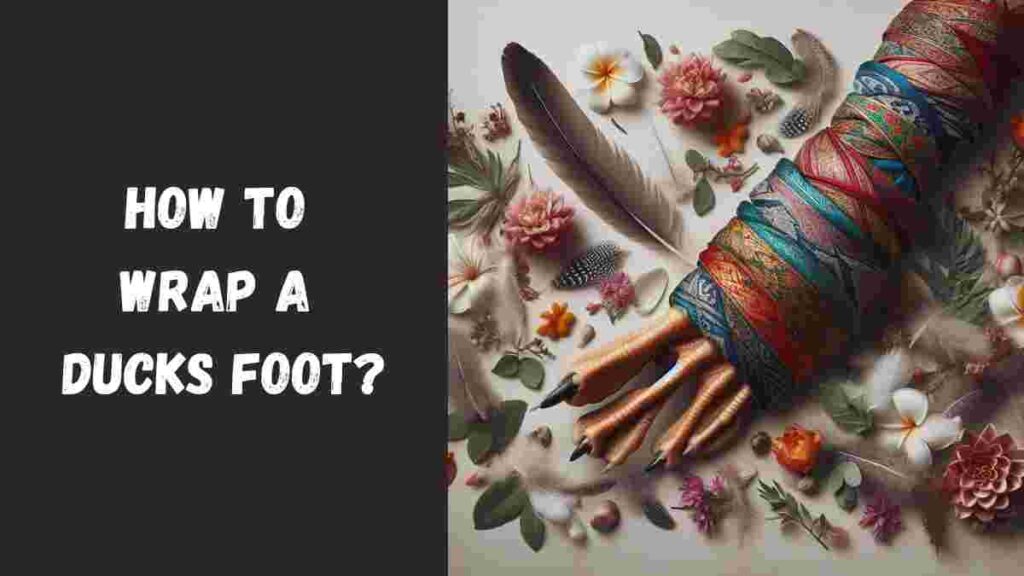How to Wrap a Ducks Foot: Poultry care involves many facets beyond the basic feed-and-water regimen. Ducks, in particular, come with their own set of unique needs, foot care being a significant one. Foot wrapping for ducks, a practice that might seem obscure to some, is actually a crucial technique for aiding in rehabilitation and preventing further injuries.
In this comprehensive guide, we’ll walk you through the process step by step, demystifying the ‘how’ and ‘why’ of this beneficial method that every responsible waterfowl owner should acquaint themselves with.
Let’s find out the answer to the question, “How to wrap a ducks foot?“
Get the best tape for your duck

Table of Contents
Introduction to Duck Foot Wrapping – How to wrap a ducks foot?
When a duck experiences a foot injury or is born with a deformity, it can lead to complications in walking, standing, and overall mobility. Foot wrapping, much like how humans employ casts and bandages, provides support to the affected area and encourages a healthy recovery. It’s an essential skill for poultry enthusiasts and avian health professionals alike.
Understanding the Purpose
At its core, the purpose of duck foot wrapping is multi-fold:
- Protection of the wound: Wrappings shield open injuries from further contamination and minimize the risk of infection, which is especially important for waterfowl.
- Immobilization for recovery: By restricting movement in a controlled manner, wrapping aids in the healing process of strains, sprains, and minor fractures.
- Alignment correction: Deformities can be supported and, in some cases, corrected with the right wrapping technique.
Preparation and Materials
Before beginning the wrapping process, it’s essential to gather the necessary supplies to streamline the procedure.
Necessary Supplies
- Non-stick gauze pads: For direct wound coverage without causing adhering.
- Medical tape or bandage: To secure the wrapping material without the risk of it sticking to the duck’s feathers.
- Soft padding material: Necessary for cushioning the affected area and providing comfort.
- Scissors: To cut the materials to the required length safely.

Step-by-Step Guide
It’s crucial to wrap a duck’s foot with precision and care. Here’s an in-depth look at each stage of the process.
Preparation
- Begin by thoroughly cleaning and drying the duck’s foot to avoid infection.
Padding
- Apply a soft padding material like gauze to the foot, creating a comfortable barrier between the foot and the wrapping.
First Layer
- Start wrapping the affected area with non-stick gauze, ensuring that it keeps the padding in place and doesn’t exert too much pressure.
Immobilization Layer
- Add a layer of tape or bandage over the initial wrapping to secure and immobilize the foot without over-constricting blood flow.
Support Layer
- Depending on the injury, a supporting layer may be needed. This should be less tight than the immobilization layer and offer reinforcement and comfort.
Final Check
- Confirm the wrapping is not too tight by ensuring that a finger can be inserted between the material and the duck’s skin. Movement should be restricted, but not to the extent that it cuts off circulation.
Importance of Proper Wrapping
A well-wrapped foot can make all the difference in a duck’s quality of life during the recovery stage.
Benefits for the Duck
- A correctly applied wrap can increase comfort and mobility.
- It can aid in faster and safer recovery from a variety of foot issues.
- For rehabilitative purposes, it can prepare the duck for a transition back to normal use.

Potential Risks and Precautions
Despite the benefits, there are inherent risks in wrapping a duck’s foot.
Avoiding Harm
- Always monitor the duck after the wrapping to ensure they are not in pain or displaying signs of discomfort.
- If there are any signs of swelling, discoloration, or compromised blood flow, the wrapping should be immediately removed.
- Make sure the materials used are non-toxic and non-allergenic to your duck.
When to Seek Veterinary Assistance
Knowing when to involve a professional is as important as knowing how to wrap a duck’s foot.
Signs of Issues
- If the duck is in distress or the injury seems severe, do not wait – seek immediate veterinary attention.
- Persistent swelling, redness, or drainage from the wrapped foot could indicate an underlying issue.
- If your duck is not recovering as expected, a vet can provide further evaluation and treatment options.
Frequently Asked Questions (FAQ) – How to wrap a ducks foot?
How often should a duck’s foot wrapping be changed?
Typically, a foot wrapping is changed every 3-5 days or as necessary, depending on the healing progress.
Can I use over-the-counter bandages for duck wrapping?
While some over-the-counter materials can be used, it’s recommended to seek out bandages specifically designed for use on animals that won’t cause allergies or toxicity.
Is it possible to wrap a duck’s foot too tightly?
Yes, and over-constriction can lead to serious issues. Always err on the side of caution and use tape and bandages with a light touch.
Is it necessary to wrap a duck’s foot for minor injuries?
While minor injuries may not always require wrapping, it’s essential to assess the situation and provide appropriate care to prevent further complications.
How often should I change the wrapping on my duck’s foot?
It’s a good idea to change the wrapping regularly, especially if it gets dirty or wet. Monitor the foot closely and adjust the wrapping as needed.
Can I use regular bandages or tape for wrapping a duck’s foot?
It’s best to use materials specifically designed for veterinary use, such as cohesive bandages and veterinary tape, to ensure proper support and comfort for the duck.
What should I do if my duck resists the wrapping process?
If your duck is resistant to being wrapped, try to approach the process calmly and gently. You may need to enlist the help of another person to hold the duck still while you wrap its foot.
How long does it typically take for a duck’s foot to heal with proper wrapping?
The healing time can vary depending on the severity of the injury or condition. With proper care and wrapping, most minor injuries should show improvement within a few days to a couple of weeks. However, it’s essential to continue monitoring the foot until it’s fully healed.
Wrapping Up – How to wrap a ducks foot?
In conclusion, the art of wrapping a duck’s foot is as much a science as an expression of caring for these special creatures. By mastering this technique, you empower yourself to assist your duck’s recovery from injuries and conditions that may otherwise compromise their well-being.
Remember, patience and attention to detail are key when tending to your duck’s foot care needs. Your dedication to their health is a direct reflection of the strong bond between you and your feathered companions.
Hope, you found the answers to the question “How to wrap a ducks foot?“
